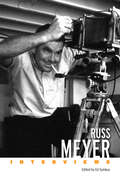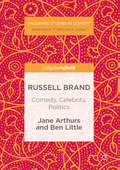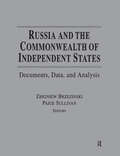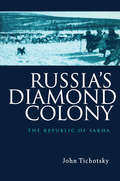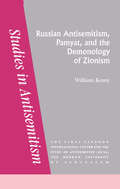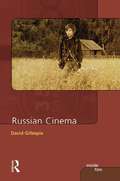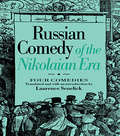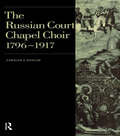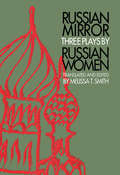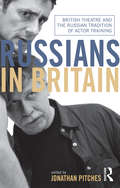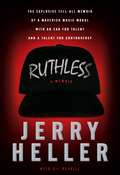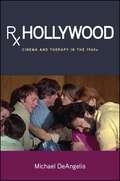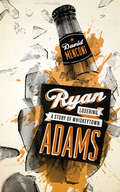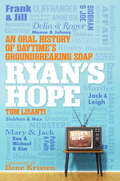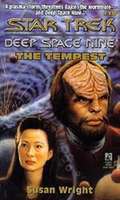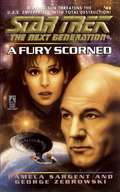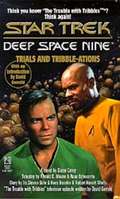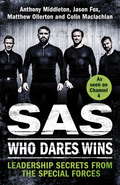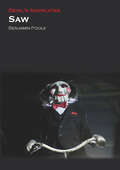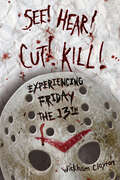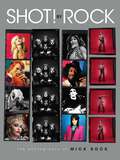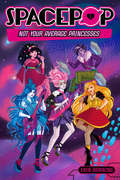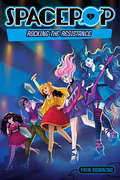- Table View
- List View
Russ Meyer: Interviews (Conversations with Filmmakers Series)
by Ed SymkusRuss Meyer: Interviews offers a detailed look into the mind, life, and successful career of the maverick filmmaker Russ Meyer. Known for his audacious visual style and boundary-pushing content, Meyer (1922–2004) carved out a unique niche in the film industry with his provocative and often controversial works, including Faster, Pussycat! Kill! Kill!; Beyond the Valley of the Dolls; and Vixen! In this volume, Meyer talks over the course of eighteen newspaper and magazine interviews—conducted between the late 1960s and early 1990s—about assignments in still- and motion-picture combat photography during World War II, learning all aspects of the filmmaking craft when he was shooting industrial films after the war, later stumbling into the business of photographing pin-up girls for magazines, and how that segued into his first forays in what would become the sexploitation movie market. Working with small budgets and small crews, Meyer became a skilled director and pitchman for his own work, hitting the road with reels of film in his car, going from town to town, getting them shown in small moviehouses, building an audience, making big profits, then using them to make his next film. The films were expertly photographed, inventively edited, and featured intriguing (and violent, carnal, and funny) storylines, and ticket sales numbers eventually caught the eyes of the Hollywood studio system, for which Meyer briefly worked, before once again striking out on his own with ever-more violent, sexual, and cartoonish features. Meyer made fortunes, he lost fortunes, then he made them again, and he was always game for getting involved in controversy, which was easy due to the content of his films. After his final theatrical feature—Beneath the Valley of the Ultra-Vixens—in 1979, Meyer reinvented himself as an entrepreneur by making his films available on the burgeoning home video market, leaving him a celebrated and very wealthy man.
Russell Brand: Comedy, Celebrity, Politics
by Jane Arthurs Ben LittleRussell Brand is one of the most high profile and controversial celebrities of our time. A divisive figure, his ability to bounce back from adversity is remarkable. This book traces his various career stages through which he has done this, moving from comedy, to TV presenting; from radio to Hollywood films. It identifies how this eclectic career in entertainment both helped and hindered his high-profile move into political activism. Underpinning the book are interviews with leading activists and politicians, and sophisticated readings of Brand's performances, writing and on-screen work. There are sections on the Sachsgate scandal, his Newsnight interview with Jeremy Paxman, and his 2015 election intervention for aspiring Prime Minister Ed Miliband. It builds on scholarly work in the area of celebrity politics to develop an original analytic approach that blends the field theory of Pierre Bourdieu with the assemblage theory of Gilles Deleuze and Felix Guattari.
Russia and the Commonwealth of Independent States: Documents, Data, and Analysis
by Zbigniew K BrzezinskiThis work brings together major accords and protocols that form the institutional framework of the Commonwealth of Independent States (CIS); a selection of policy statements by the leaders of CIS countries; a chronological record of political, economic and military security developments and major crises in CIS "hot spots"; and statistics and country profiles.
Russia's Diamond Colony: The Republic of Sakha
by John TichotskyThis study looks at the reform process in Sakha and at a one hundred year history of economic development. The research revealed that Sakha's progress has always been determined by the export of key resources.
Russian Antisemitism Pamyat/De (Studies In Antisemitism Ser. #Vol. 2.)
by CoreyFirst Published in 1995. Routledge is an imprint of Taylor & Francis, an informa company.
Russian Cinema (Inside Film)
by David C. GillespieRussian Cinema provides a lively and informative exploration of the film genres that developed during Russia's tumultuous history, with discussion of the work of Eisenstein, Pudovkin, Mikhalkov, Paradzhanov, Sokurov and others. The background section assesses the contribution of visual art and music, especially the work of the composers Shostakovich and Prokofev, to Russian cinema. Subsequent chapters explore a variety of topics: The literary space - the cinematic rendering of the literary text, from 'Sovietized' versions to bolder and more innovative interpretations, as well as adaptations of foreign classics The Russian film comedy looks at this perennially popular genre over the decades, from the 'domestication' of laughter under Stalin to the emergence of satire The historical film - how history has been used in film to affirm prevailing ideological norms, from October to Taurus Women and Russian film discusses some of the female stars of the Soviet screen (Liubov Orlova, Vera Alentova, Liudmila Gurchenko), as well as films made by male and female directors, such as Askoldov and Kira Muratova Film and ideology shows why ideology was an essential component of Soviet films such as The Maxim Trilogy, and how it was later definitively rejected The Russian war film looks at Civil War and Second World War films, and the post-Soviet treatment of recent conflicts in Afghanistan and Chechnya Private life and public morality explores the evolution of melodramas about youth angst, town and village life, personal relationships, and the emergence of the dominant sub-genre of the 1990s, the gangster thriller Autobiography, memory and identity offers a close reading of the work of Andrei Tarkovskii, Russia's greatest post-war director, whose films, including Andrei Rublev and Mirror, place him among the foremost European auteur film-makers Russian Cinema offers a close analysis of over 300 films illustrated with representative stills throughout. As with other titles in the Inside Film series it includes comprehensive filmographies, a thorough bibliography and an annotated further reading list. The book is a jargon-free, accessible study that will be of interest to undergraduates of film studies, modern languages, Russian language and literature, as well as cineastes, film teachers and researchers.
Russian Comedy of the Nikolaian Rea (Russian Theatre Archive Ser.)
by Laurence SenelickThese four Russian comedies were written during the reign of Nicholas I, a period of considerable repression and censorship. They represent the most popular genres of the period. Lensky's Her First Night was an immensely popular vaudeville which held the stage for years; Kozma Prutkov's Fantasy is a parody of vaudeville which was banned after one night. Turgenev's Luncheon with the Marshal is a comedy of manners about provincial life, and Saltykov-Schedrin's Pazukhin's Death is a satire of greed and corruption so savage that it was forbidden during the author's lifetime. This collection constitutes a remarkable comic spectrum which will assist in enlarging the English language repertoire with a set of newly available and hightly stageworthy scripts.
Russian Court Chapel Choir: 1796-1917 (Music Archive Publications)
by Carolyn C. DunlopFirst Published in 2000. Routledge is an imprint of Taylor & Francis, an informa company.
Russian Mirror: Three Plays by Russian Women (Russian Theatre Archive Ser. #Vol. 14.)
by Melissa T. SmithThe three playwrights presented together in this volume On the Road to Ourselves), Elena Gremina (Behind the Mirror) and Olga Mikhailova (Russian Dream). The selected plays contain many elements which will appeal to Western directors and audiences: well-drawn characters, engaging plots, lively wit. Central to the three plays selected in this volume is a complex interaction of Russian and Western value systems, a theme that becomes increasingly relevant for Russian audiences with each passing season and no less relevant for Europeans and Americans.
Russian and Soviet Film Adaptations of Literature, 1900-2001: Screening the Word (BASEES/Routledge Series on Russian and East European Studies #Vol. 18)
by Stephen Hutchings Anat VernitskiProviding many interesting case studies and bringing together many leading authorities on the subject, this book examines the importance of film adaptations of literature in Russian cinema, especially during the Soviet period when the cinema was accorded a vital role in imposing the authority of the communist regime on the consciousness of the Soviet people.
Russians in Britain: British Theatre and the Russian Tradition of Actor Training
by Jonathan PitchesFrom Komisarjevsky in the 1920s, to Cheek by Jowl’s Russian ‘sister company’ almost a century later, Russian actor training has had a unique influence on modern British theatre. Russians in Britain, edited by Jonathan Pitches, is the first work of its type to identify a relationship between both countries’ theatrical traditions as continuous as it is complex. Unravelling new strands of transmission and translation linking the great Russian émigré practitioners to the second and third generation artists who responded to their ideas, Russians in Britain takes in: Komisarjevsky and the British theatre establishment. Stanislavsky in the British conservatoire. Meyerhold in the academy. Michael Chekhov in the private studio. Littlewood’s Theatre Workshop and the Northern Stage Ensemble. Katie Mitchell, Declan Donnellan and Michael Boyd. Charting a hitherto untold story with historical and contemporary implications, these nine essays present a compelling alternative history of theatrical practice in the UK.
Ruthless: A Memoir
by Gil Reavill Jerry Heller"PAYBACK'S A BITCH, JERRY." The words scrawled crudely across Jerry Heller's bedroom mirror that afternoon meant the rap wars had suddenly escalated. In the battle of his life over the ragingly successful music label he had helped found, Ruthless Records, Heller had seen death threats, strong-arming, and beatings. Now the violence had come home when his enemies burglarized his house, jacked his Corvette, and left behind this sneering piece of graffito. Heller didn't get mad; he got even. Ruthless tells the explosive story of Jerry Heller's alliance with Eric Wright, aka Eazy-E, one of the legends of rap music and a founding member of N.W.A., "the world's most dangerous band." As a longtime music industry superagent, Heller had the skill and insight necessary to guide N.W.A.'s cometlike rise to the top of the charts. Along the way there were raucous nationwide tours, out-of-control MTV pool parties, and X-rated business meetings. Heller held on through the brutal shocks and reversals of the Ruthless Records era, which saw the label being targeted by the FBI, and its principal artists locked in bitter conflict, until a final turnaround placed Ruthless at the top of the heap once more. Always in the middle of the whirlwind were Jerry and Eazy, an odd-couple pairing that represents one of the deepest and most appealing stories in American music. You don't have to be an N.W.A. fan to love Ruthless. Heller turns the music industry inside out, exposing its strange logic and larger-than-life personalities. Ruthless provides keen insight into the popular music scene, with an unforgettable portrait of its rollicking excesses, life-churning drama, and multimillion-dollar highs.
Rx Hollywood: Cinema and Therapy in the 1960s (SUNY series, Horizons of Cinema)
by Michael DeAngelisRx Hollywood investigates how therapy surfaced in the themes, representations, and narrative strategies of a changing film industry. In the 1960s and early 1970s, American cinema was struggling to address adult audiences who were increasingly demanding films that confronted contemporary issues. Focusing upon five fields of therapeutic inquiry—therapist/patient dynamics, female "frigidity" and male impotence, marital discord, hallucinogenic drug use, and the dynamics of confession—Michael DeAngelis argues that the films of this period reveal an emergent, common tendency of therapy to work toward the formation of a stronger sense of interpersonal, community/social, and political engagement, counteracting alienation and social division in the spirit of connection and community.Prior to the 1960s, therapy had been considered an introspective process, one that emphasized contemplation and insight and prompted the patient to investigate memories and past traumas. In the 1960s, however, therapy would move toward more humanistic, client-centered, community, group, and encounter models that deemphasized the "there and then" of past feelings and experiences and embraced the "here and now" of the present. These kinds of therapy promised to heal the self through a process of reaching out, helping individuals to connect with communities, support networks, and other like-minded individuals who shared a needed sense of belonging.Drawing on a wide range of films, including Marnie, The Boston Strangler, The Chapman Report, Carnal Knowledge, Divorce American Style, Diary of a Mad Housewife, Guess Who's Coming to Dinner, and Five Easy Pieces, DeAngelis shows how American culture framed therapeutic issues as problems of human communication, developing treatment strategies that addressed individual psychological problems as social problems.
Ryan Adams: Losering, A Story of Whiskeytown (American Music Series)
by David MenconiBefore he achieved his dream of being an internationally known rock personality, Ryan Adams had a band in Raleigh, North Carolina. Whiskeytown led the wave of insurgent-country bands that came of age with No Depression magazine in the mid-1990s, and for many people it defined the era. Adams was an irrepressible character, one of the signature personalities of his generation, and as a singer-songwriter he blew people away with a mature talent that belied his youth. David Menconi witnessed most of Whiskeytown's rocket ride to fame as the music critic for the Raleigh News & Observer, and in Ryan Adams, he tells the inside story of the singer's remarkable rise from hardscrabble origins to success with Whiskeytown, as well as Adams's post-Whiskeytown self-reinvention as a solo act. Menconi draws on early interviews with Adams, conversations with people close to him, and Adams's extensive online postings to capture the creative ferment that produced some of Adams's best music, including the albums Strangers Almanac and Heartbreaker. He reveals that, from the start, Ryan Adams had an absolutely determined sense of purpose and unshakable confidence in his own worth. At the same time, his inability to hold anything back, whether emotions or torrents of songs, often made Adams his own worst enemy, and Menconi recalls the excesses that almost, but never quite, derailed his career. Ryan Adams is a fascinating, multifaceted portrait of the artist as a young man, almost famous and still inventing himself, writing songs in a blaze of passion.
Ryan's Hope: An Oral History of Daytime's Groundbreaking Soap
by Tom LisantiIn the vein of the bestselling Nothing General About It and Always Young and Restless, a revelatory account of the pioneering Emmy Award-winning, beloved daytime drama— featuring the words of stars including Helen Gallagher, Malcolm Groome, Ron Hale, Ilene Kristen, Michael Levin, Ana Alicia, Roscoe Born, Catherine Hicks, Geoff Pierson, Andrew Robinson, and Gordon Thompson, along with writers, producers, directors and family members—plus never-before-seen photos and plot synopses. From the opening scene of its first episode, in which Mary Ryan walks jauntily down a New York City street to her family&’s neighborhood bar, it was clear that Ryan&’s Hope would be unlike every daytime soap that had come before. Indeed, from 1975 to 1989, the Emmy award-winning ABC TV serial drew viewers into the world of Maeve and Johnny Ryan, their children, friends, and extended family. This page-turning chronicle gathers memories and exclusive interviews to reveal the show&’s fascinating origin story—and explore why it&’s missed to this day. Ryan&’s Hope was set in a real city, within recognizable communities. The working-class, Irish-Catholic, immigrant Ryans were the core of a show that credibly tackled such topics as infidelity, addiction, religious faith, and women&’s rights. There was melodrama, to be sure, but also heart, depth, grit—provided by co-creators and head writers Claire Labine and Paul Avila Mayer. Labine and Mayer were also the executive producers in the early years, which gave them full control over their creation, from character backstories to lighting and costume. But there were also some missteps along the way, from the constant recasting of fan-favorite characters to ABC&’s ill-judged attempts to infuse the homey, family-oriented show with intrigue and adventure. Featuring the words of stars including Helen Gallagher, Malcolm Groome, Ron Hale, Ilene Kristen, Michael Levin, Ana Alicia, Roscoe Born, Catherine Hicks, Geoff Pierson, Andrew Robinson, and Gordon Thomson, along with writers, producers, production crew, and family members—plus never-before-seen photos and plot synopses—soap opera fans will find this insider account as captivating as the beloved show itself.
S/trek Ds9 #19 The Tempest (Star Trek #19)
by Susan WrightWhen a ferocious plasma storm strikes the entire Bajoran system, Deep Space NineTMbecomes a port under siege, filled to overflowing with stranded space travelers, unpredictable aliens, and Klingon smugglers. Wof and Odo find themselves tested to the limit as they struggle to control the chaos that has consumed the station. But even greater danger faces Dax and botanist Keiko O' Brian when they must fly a runabout into the very heart of the storm - and encounter a stange new form of life!
S/trek Ng 43: A Fury Scorned (Star Trek #43)
by Pamela SargentWith their sun about to go nova, the people of Epictetus III face annihilation. Although the U.S.S. Enterprise has come to lead the rescue operation, there is no way to evacuate a population of over twenty million, leaving Captain Picard to make an agonizing decision. Should he try to salvage the planet's children, its greatest leaders and thinkers, or its irreplaceable archeological treasures? No matter what he decides, millions must be sacrificed -- unless another solution can be found. With time running out, Data proposes a revolutionary scientific experiment that could save all of Epictetus III, or doom both the planet and the Enterprise as well.
S/trek Trials And Tribble-ations (Star Trek)
by Diane CareyAlmost a century ago, Captain James T. Kirk and the crew of the Starship Enterprise first encountered the irresistible (and astonishingly prolific) life-form known as the Tribbles5, resulting in one of the most unususal adventures in the annals of Starfleet. Now Captain Benjamin Sisko and the crew of the Defiant are transported back in time to that historic occasion, where Darvin, a devious Klingon spy, plots revenge against Captain Kirk. Using the seemingly harmless tibbles, Darvin attempts to destroy Kirk -- but for the misplaced residents of Deep Space Nine saving the original Enterprise willbe nothing but ""tribble."" An exciting new novel based on the most mind-boggling STAR TREK: DEEP SPACE NINE adventure of them all!
SAS: Leadership Secrets from the Special Forces
by Jason Fox Anthony Middleton Matthew Ollerton Colin MaclachlanLife and leadership lessons from the Special Forces, from the stars of Channel 4 series SAS: Who Dares Wins - including Sunday Times bestselling author of FIRST MAN: LEADING FROM THE FRONT, Ant MiddletonAre you up to the challenge of SAS leadership? Only the best will succeed... Britain's SAS (Special Air Service) has an unparalleled reputation for soldiering excellence. Their skills and techniques have been perfected in the most demanding environments imaginable, but many of these can also be used in our everyday lives. This book takes situations all of us will experience during our lives and presents tactical lessons drawn from SAS training and battlefield experience. Its four authors - stars of the hit Channel 4 show SAS: Who Dares Wins - how their finely honed understanding of how to handle extreme challenges can be applied in any environment. Their advice on negotiation, people management, self-motivation and resilience, among other things, can transform your performance in a whole range of scenarios: from buying a house, nailing a job interview, and the experience of dealing with rejection, to maintaining a diet, or managing that pushy colleague at work.This is the ultimate guide to leadership and personal achievement.
SAW
by Ben PooleLike all game changers within the horror genre, SAW was an independent success, a low-budget champion that flourished without the patronage of a big studio. Not bad for the most successful horror franchise ever, which has spawned subsidiary media and masses of merchandise, including a theme park rollercoaster ride. What is it about SAW that attracted such a following? In his contribution to the "Devil's Advocates" series, Ben Poole considers the SAW phenomenon from all aspects of film and media studies - from its generic pedigree in both literature and film, to the visceral audience pleasures ("what would I do?") of the text, to the contrasting representations of men and women and the film's implicit criticism of masculinity.
SAW (Devil's Advocates)
by Ben PooleLike all game changers within the horror genre, SAW was an independent success, a low-budget champion that flourished without the patronage of a big studio. Not bad for the most successful horror franchise ever, which has spawned subsidiary media and masses of merchandise, including a theme park rollercoaster ride. What is it about SAW that attracted such a following? In his contribution to the "Devil's Advocates" series, Ben Poole considers the SAW phenomenon from all aspects of film and media studies – from its generic pedigree in both literature and film, to the visceral audience pleasures ("what would I do?") of the text, to the contrasting representations of men and women and the film's implicit criticism of masculinity.
SEE! HEAR! CUT! KILL!: Experiencing Friday the 13th
by Wickham ClaytonSean S. Cunningham and Victor Miller’s Friday the 13th franchise is one of the most successful horror film franchises in history. To date, it includes twelve movies, a television show, comic books, and video games, among other media. In SEE! HEAR! CUT! KILL! Experiencing “Friday the 13th,” Wickham Clayton explores several aspects of the films including how the technical aspects relate to the audience, their influence on filmmaking, and the cultural impact of the franchise. Clayton looks at how perspective is established and communicated within the Friday the 13th films, which is central to the way the audience experiences and responds emotionally to these movies. Then he considers how each sequel gives viewers, whether longtime fans or new audiences, a “way in” to the continuous story that runs through the series. Clayton also argues that the series has not developed in isolation. These films relate to contemporary slasher films, the modern horror genre, and critically successful Hollywood films in general. They reflect popular trends of film style and often act as key examples in the genre and beyond.
SHOT! by Rock: The Photography of Mick Rock
by Mick RockBorn in 1948 in Hammersmith, London, Michael Rock became a photographer after graduating from college, and developed his visual style with photos of the local rock music scene in England. Soon thereafter his photography career took off, going higher and higher with each new musician he shot for. His work is embodied in this text, full of luscious, color-saturated photography of some of the most dynamic and enthralling musical acts and stars in rock history—and likewise filled with amazing and amusing behind-the-scenes stories of musicians from Mick Jagger to Miley Cyrus and beyond. A sure-fire hit with rock and musical history fans!
SPACEPOP: Not Your Average Princesses (SPACEPOP #1)
by Erin DowningFive galactic princesses go into hiding when the evil Empress Geela invades their home planets and captures their parents. Athena, Luna, Rhea, Hera, and Juno decide they can't stand by and watch Geela destroy their homeworlds! Five awesome makeovers later, the girls form a band called SPACEPOP to spread the rebel message of freedom and resistance through music. But when the princesses are recruited as secret agents, can they keep their true identities under wraps?This book includes two full-color illustrated graphic novel sections for 24 total pages of comic book fun!This middle-grade adventure series will resonate with girls eight to twelve who love fashion, music, friendship, and fun!An Imprint Book <P><P> <i>Advisory: Bookshare has learned that this book offers only partial accessibility. We have kept it in the collection because it is useful for some of our members. Benetech is actively working on projects to improve accessibility issues such as these.</i>
SPACEPOP: Rocking the Resistance (SPACEPOP #2)
by Erin DowningPop stars by day, secret agents by night! <br>The band called SPACEPOP gains fame across the galaxy, spreading a message of rebellion through music. But with huge fame comes huge problems! The five princesses of the pentangle, Athena, Luna, Rhea, Hera, and Juno, are finding it harder to keep their secret identities under wraps between TV appearances, commercials, and the upcoming Battle of the Bands! <br>Everyone is taking notice--especially the evil Empress Geela, who grows jealous of the hot new band. When Geela launches an offensive, SPACEPOP embarks on their most dangerous mission yet. These five undercover princesses need to save their planets and their parents! With the stakes higher than ever, SPACEPOP's ready to rock the resistance! See the band rock out in two full-color inserts inside!An Imprint Book
